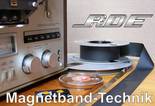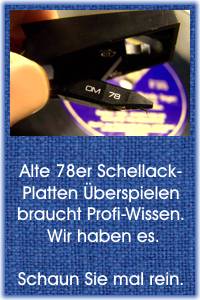Zum Auffrischen und Schmunzeln . . .
. . . sind diese Museums-Seiten hier gedacht, denn viele wissen nicht mehr oder noch nicht, wie es damals angefangen hat und wie das wirklich funktioniert mit den Tonband- und den Magnetbandgeräten aus alter Zeit. Viele Bilder können Sie durch Anklicken vergrößern, auch dieses.
In dieser Download-Liste finden Sie alle Informationen, wie Sie von dem Download-Server Dateien, Video-Filme, Musiken und Bilder/Fotos runter laden können. Alle Ankündigungen in allen Museen-Seiten verweisen auf diese eine Liste.
.
Ermutigt durch die hohe Qualität der HF Vormagnetisierung von 1940/41 .....
.... gab es vielversprechende Ideen und Entwicklungen. So bauten die Berliner AEGler auch gegen den Willen der obersten xxxxxxxx-Leitung so ab 1943 ein Stereo-Bandgerät. Als Chassis diente natürlich ein inzwischen fast ausgereiftes Magnetophon AEG K4. Überliefert ist die Stereo-Version unter der Bezeichnung Magnetophon AEG K7.
Und von einem dieser Stereo Experimente ist eine gute Aufnahme erhalten.
Der Weg dieser Aufnahme geht sicher über Russland, denn die Russen haben ab April 1945 alles, das nicht niet- und nagelfest war, abtransportiert, auch und insbesondere aus Berlin natürlich.
Selbst wenn sie nicht wussten, was mit mit dem "Hightech Zeugs" da anzufangen war, es war dann erst mal auf Jahre weg.
Also, wir haben eine 1944er Version von Beethoven's Klavierkonzert No.5 Opus 73 des Berliner Reichssender Symphony Orchesters (andere sprechen vom Berliner Radio Symphonie Orchester) mit Walter Gieseking bekommen. Der Dirigent war damals Artur Rother.
Ein Amerikaner beschreibt das 1978 so:
About very early Stereo Recordings on Tape
Die Übersetzung kommt irgendwann noch. (Oder haben Sie schon eine ??)
The fundamentals of stereo theory and microphone placement (specifically the "crossed mikes" technique) were established in England in 1931 by A. D. Blemlein of the Columbia Gramophone Company (now a part of EMI). Some experimental two-channel discs were made in 1933 as a part of that research. These recordings, which have never been released, were conducted by Sir Thomas Beecham and include a Mozart "Jupiter".
Also in the early 1930's Bell Laboratories conducted some stereophonic experiments in the United States culminating in a direct-line live transmission in collaboration with Leopold Stokowski. Though this was not recorded, it may have planted the seed which later resulted in Stokowski's 1939 nine-channel "Fantasia" recording on optical film.
In several countries research had been slowly progressing on methods of recording an audio signal magnetically on lengths of paper tape coated with iron oxide. But it was in Germany in the late 1930's and early 1940's that this goal was finally realized and brought to a measure of perfection. The development of dual-channel recording followed immediately and it was on one of the Magnetophon recorders then developed that the present recording was made.
Rumors of stereo tapes of Furtwangler's wartime performances have never been confirmed by their issuance on records, but it seems likely that those - and possibly dual-channel tapes by Richard Strauss - did or do exist, possibly in East Germany or the Soviet Union.
One other 1944 stereo is known: one movement only of the Bruckner "Eighth Symphony" (the "Finale"), conducted by Herbert von Karajan. It has been issued by the Bruno Walter Society.
In the United States strong interest in stereophonic and binaural recording techniques firstly began to emerge about 1952. Tapes with the National Philharmonic Orchestra of Washington, D.C. were reportedly made by the Berlant Concertone Tape Recorder Company, but they have never appeared commercially. Stereo tapes sponsored by another recorder manufacturer - Webcor - did, however, appear briefly about 1954 and some of these are now available on disc from Everest Records.
Emory Cook, founder of Cook Laboratories, made a number of stereo tapes beginning in 1952. He was the first to record "on location" with the new medium. In 1952/53 he designed and marketed a dual arm and cartridge "binaural" disc playback system and made stereo records of an orchestra drawn from the Boston Symphony. These are still available, recut in the regular stereo mode. Leopold Stokowski also made dual channel tapes in 1952. These were recorded, at his request, by an independent engineer and have never been released.
In 1953 Audiosphere Electronics (later called Livingston) introduced the first substantial catalogue of half-track reel-to-reel recorded tapes. The A.V. Company also issued stereophonic tapes in conjunction with Remington Records, and these recordings are now available on Varese Sarabande (the Sibelius "Origin of Fire" and Dvorak "Eighth Symphony", both with the Cincinnati Symphony Orchestra).
Among other U.S. companies then experimenting with the new technique were Concert Hall Society (1952) and Mercury Records (1953). In England, Decca/London recorded Ansermet stereophonically in 1953 (Balakirev: Thamar) under the supervision of engineer Arthur Haddy. By 1954 most of London's operas and a large percentage of the orchestralrecordings were two-channel - many are still in print today. In Europe, the Swedish Society Discophil recorded Hugo Alfven conducting his works in 1954. That same year RCA Victor opened its stereo chapter with the impressive Fritz Reiner/ Chicago "Also sprach Zarathustra" as well as the Toscanini/NBC stereo tapings - which have yet to be released.
Much impetus had been given to the development of the new medium by use of "Stereophonic Sound" in major motion pictures. This, like 3-D, was an attempt to counter the audience-draining effects of television. Such pictures as "This Is Cinerama" and "The Robe" (both 1952) made much of their "sound systems". The latter even had sequences featuring rear-channel quad effects.
By 1955/56 many companies were recording in stereo and half-track recorded tapes were widely available (for prices of up to $18.95) in "Hi-Fi stores" and camera shops. By 1957 Decca/London had developed the now-standard "45/45" record cutting technology (in collaboration with American Westrex) and later that year Audio Fidelity became the first label to market a regular stereo disc. From 1958 on stereo established itself in the United States home faster than any recent technological development except the transistor.
Der Amerikaner Tom Null schreibt weiter:
"About this recording . . . ."
During the late 1930's the RRG (the German radio system in Berlin) perfected magnetic tape recording and began employing it in various ways - principally for the broadcast of propaganda speeches, and music. It was not, however, until after the war that captured Magnetophon recorders, brought home by booty and enterprising Gl's (Jack Mullin), appeared in the U.S. These machines, which formed the nucleus for several companies (most notably Ampex) competed briefly with home disc recording systems and wire recording before establishing their supremacy. Though many recordings made in Germany during the war have been issued lately during the seventees by a number of labels over the years, this is the first commercial release of a stereo recording from that era and appears to be the earliest complete stereo tape in existence.
Recorded in the Autumn of 1944, this recording features Walter Gieseking at what was perhaps the height of his technique. With this release there are now four different versions of this pianist's "Emperor" commercially available, the others being: a 1938 recording (Vox/Turnabout, mono); a 1950 performance (Odyssey, mono) and a 1955 stereo taping (Seraphim).
The background hiss (noise) heard on this recording is on the original tape. It has been reduced a bit, but to have eliminated it entirely would have required a cut of the upper frequencies and a loss of depth and transparency in the sound. Some variations in the volume levels between the two channels have been corrected for as much as possible and a slight tendency to "tubbiness" in the bass has been minimized in this mastering.
Parallels between the wartime circumstances amid which this performance was recorded and the siege conditions in Vienna in 1809 are striking and ironic indeed. Toward the end of side one, in the middle of the cadenza, one can faintly hear what must have been anti-aircraft guns firing outside the recording hall. Beethoven, could he have known, would surely have covered his ears again - sorrowed that despite the passage of 121 years the message of brotherhood so eloquently conveyed by his Ninth Symphony had fallen on still deafer ears.
In dieser Download-Liste finden Sie alle Informationen, wie Sie von dem Download-Server Dateien, Video-Filme, Musiken und Bilder/Fotos runter laden können. Alle Ankündigungen in allen Museen-Seiten verweisen auf diese eine Liste.





